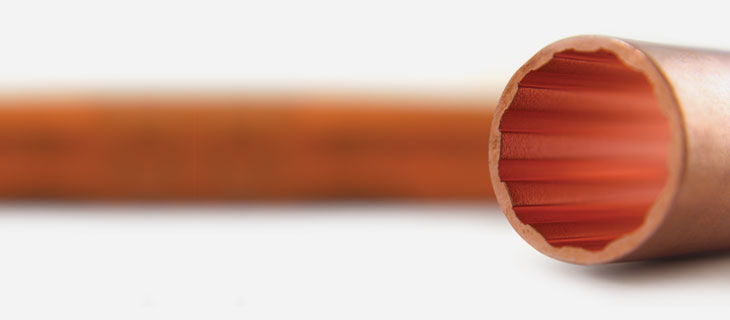Copper Tube
Copper has a single, “alpha” phase structure even up to relatively large percentage additions of secondary elements. However copper in the engineering sense is generally regarded as those alloys having less than 0.5% of any additional elements.
Thermal conductivity – better than gold or aluminium, copper excels in transferring heat. In short, drawn copper engineering tubing is used in engineering applications where a combination of properties are required:
- Electrical conductivity – and electric currents.
- Malleability – copper, especially phosphorous deoxidised copper (Cu-DHP) retains a combination of ductility and strength that has allowed it to be used for metal fabrication since before the bronze age. Because it work hardens, it can retain its formed shape after easy manipulation.
- Strength – in the hard condition copper has a tensile strength of about 385 MPa.
| Copper | 99.90 | C101 Cu-ETP | UNS C11000 | Electrolytic Tough Pitch, HC |
|---|---|---|---|---|
| 99.95 | (C103) Cu-OF | UNS C10200 | OFHC | |
| 99.85 | C106 Cu-DHP | UNS C12200 | Phosphorus Deoxidised | |
| 99.99 | (C110) SE-Cu/Cu-OFE | – | Special Electronic |
Some characteristics of drawn copper tube:
Thermal and electrical properties
Like aluminium, copper has been used in the electrical industry for many years because it offers good electrical conductivity (about 150% that of aluminium). The purer the grade, the higher the conductivity: Cu-ETP and Cu-OFE are high purity grades, widely used for electronic and electrical applications.
Copper also has good thermal conductivity at about six times that of steel. As long as other requirements are satisfied (corrosion resistance, strength and electrical characteristics) copper may be a perfect choice of material.
Corrosion resistance & coatings
Copper is termed a “noble” metal as it resists corrosion in a wide variety of media.
Plating can be used to enhance the appearance, electrical performance or corrosion resistance of copper but can also cause problems if a galvanic cell is set up between plating and the copper substrate; specialist advice should always be taken.
Strong but malleable
Copper grades attain about 385 MPa when fully hard and over 200 MPa in the soft condition. Unlike steel, copper and its alloys become stronger at low temperatures and do not suffer the ductile/brittle transition of steel.
Copper tube is widely used to fabricate complex components where the combined properties of strength and ductility are required. Typical applications include gas and oil boilers, refrigeration and air conditioning plant. Copper is also pre-eminent in the field of household water systems.
Drawn Copper Tube
Drawn Copper Tube and alloys have been designed to match capabilities to needs and are amongst the oldest materials in the service of man.
Even small additions of a second element can significantly effect a property.
The alloying elements employed to alter the characteristics of pure copper used for copper alloy engineering tubing impart differing characteristics, often in combination: strength, temperature capabilities, machining properties or corrosion resistance. They all retain to some degree basic properties of copper: ductility, thermal and electrical conductivity.
All the alloys are fairly strong: high strength alloys can be treated to achieve well over 500 MPa (aluminium brass reaches 550 and phosphor bronze over 650 MPa).
